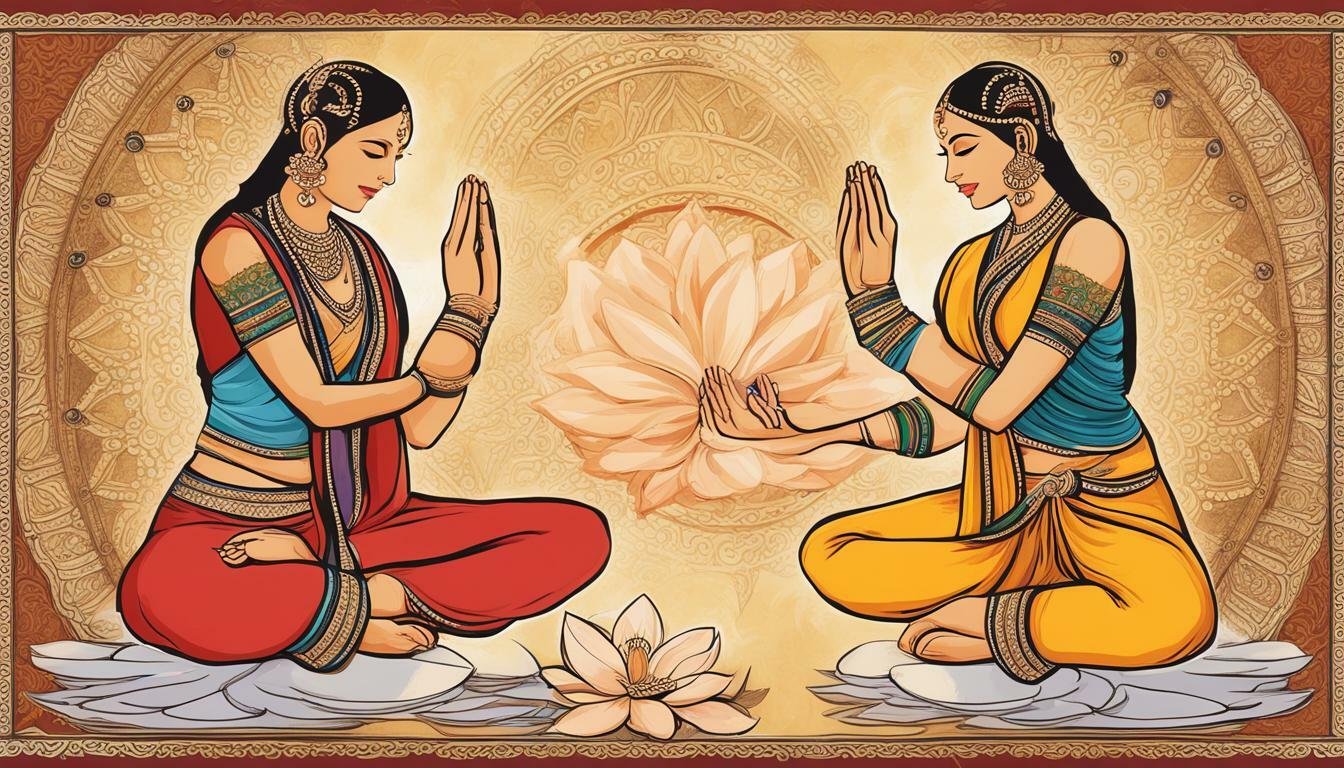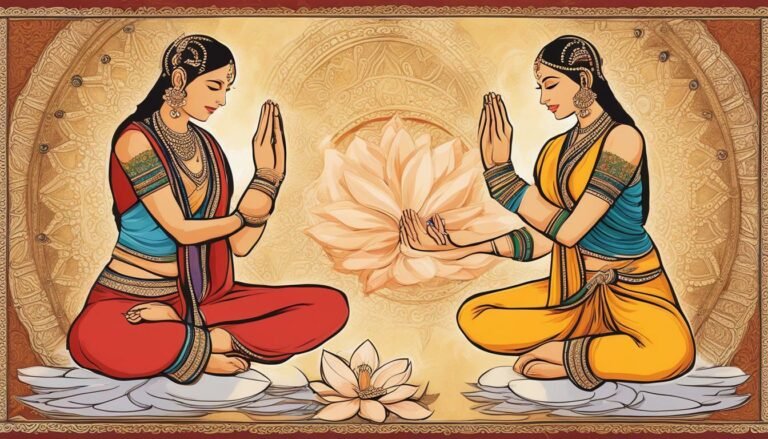
Have you ever wondered about the spiritual meaning of “Namaste” in Hindi? This ancient greeting is widely used in Hindi-speaking communities and is known for its ability to foster a sense of connection and respect between individuals. However, its spiritual significance goes much deeper than a simple greeting.
In this article, we will delve into the spiritual meaning of “Namaste” in Hindi, exploring its cultural significance and the various interpretations of the word.
Key Takeaways:
- The word “Namaste” has a spiritual connotation in Hindi culture
- “Namaste” is an expression of respect, humility, and unity among individuals
- The spiritual significance behind “Namaste” goes beyond a simple verbal greeting, and it can be incorporated into one’s daily spiritual practice
Understanding the Concept of “Namaste”
As a spiritual greeting, “Namaste” holds significant importance in Hindi culture. The word has a deeper meaning than a mere salutation and signifies an attitude of reverence and humility.
The gesture of joining hands in front of the heart and bowing slightly while saying “Namaste” represents the acknowledgment of the divine spark within every individual. It is a way of recognizing the inner spiritual essence of oneself and others, regardless of their outward appearance or social status.
The use of “Namaste” as a spiritual greeting fosters a sense of connection and unity among individuals, and it is often used in spiritual and religious contexts. In yoga, for instance, the gesture is used as a way of honoring the teacher or the divine presence within oneself and others.
Understanding the Significance of “Namaste”
The spiritual significance of “Namaste” lies in its power to recognize and honor the divine essence within oneself and others. By bowing and saying “Namaste,” one is essentially acknowledging the divine within another person and showing respect and humility towards them.
This gesture also reflects the Hindu belief in the interconnectedness of all things and the idea that everything in the universe is a manifestation of the divine. Therefore, by acknowledging the divine within every individual, “Namaste” promotes a sense of unity and oneness among all beings.
Overall, “Namaste” holds a special place in Hindi culture as a spiritual greeting that embodies the values of respect, humility, and connection. Its significance goes beyond a mere verbal greeting, and it is an important practice in fostering a deeper connection with oneself and others.
The Etymology of “Namaste”
The word “Namaste” is derived from two Sanskrit words – “namah” which means bow or reverence, and “te” which means to you. When combined, these words form the term “Namaste,” which can be translated as “I bow to you” or “I show reverence to you.”
The literal meaning of the word “Namaste” captures the essence of the greeting, which is widely used in Hindi-speaking cultures as a sign of respect and honor towards others.
However, the spiritual significance of “Namaste” goes beyond its literal translation. The gesture is not simply a physical act but also a spiritual one, symbolizing the recognition of the inner divinity within all beings.
The deeper significance of “Namaste” is reflected in the various layers of meaning embedded within the term. For example, the word “namah” can be broken down into “na” which means “not” and “mah” which means “me.” The two parts combined signify the absence of ego, a key element in spiritual practice.
Cultural Significance of “Namaste” in Hindi
“Namaste” is not just a greeting in Hindi culture, but a reflection of the values and beliefs that are deeply ingrained in Indian society. It is a humble acknowledgment of the divine spark within each individual, a way of showing respect and honor to others, and a symbol of unity and harmony.
The use of “Namaste” extends beyond personal interactions and is also a significant aspect of religious and spiritual practices in Hinduism. In the spiritual context, “Namaste” is a recognition of the divinity within oneself and others, and a gesture of reverence towards the divine.
In Indian culture, the use of “Namaste” is also a way of showing deference to elders and people in positions of authority. It reflects the cultural value of respecting one’s elders and acknowledging their wisdom and experience.
Additionally, “Namaste” is often used in formal settings, such as business meetings or official functions, as a way of showing respect and honoring the importance of the occasion.
Overall, the cultural significance of “Namaste” in Hindi cannot be overstated. It is a way of showing respect, humility, and unity, and is deeply ingrained in Indian culture and society as a whole.
Namaste as a Spiritual Practice
While “Namaste” is commonly known as a verbal greeting in Hindi, it is also a deeply spiritual practice. This practice involves using the greeting as a physical expression of spirituality, further emphasizing its significance in Hindi culture.
The act of saying “Namaste” involves placing the palms of the hands together in front of the chest and bowing the head. This physical gesture is believed to represent the recognition of the divine spark within oneself and others. It also symbolizes the unity of all living beings and the interconnectedness of the universe.
Additionally, “Namaste” can be incorporated into one’s daily spiritual routine. Some individuals may choose to say the greeting as they begin and end their yoga or meditation practice, while others may use it as a way to honor the divine within themselves and others throughout the day.
The spiritual practice of “Namaste” serves as a reminder of the importance of connection and reverence in one’s spiritual journey. By incorporating this practice into their daily routine, individuals can cultivate a deeper sense of awareness, gratitude, and humility.
Variations of “Namaste” in Hindi-Speaking Regions
The spiritual greeting “Namaste” holds significant cultural and spiritual value in various regions of India. However, the word may also have different variations, each with its own unique interpretation, depending on the region.
In some parts of India, “Namaskar” is used interchangeably with “Namaste.” “Namaskar” is a Sanskrit salutation that translates to “I bow to you.” Similarly, “Pranam” is another variation of “Namaste” that emphasizes bowing or prostration. It is commonly used especially in the Northern parts of India.
In the southern states of India, instead of “Namaste” or “Namaskar,” people use the word “Vanakkam,” which is Tamil for “greetings.” In the state of Maharashtra, the word “Namaskar” is used with a slight variation, “Namaskara,” that carries a slightly different tone and is considered more formal.
The variations of “Namaste” highlight the diversity of languages and cultures within India. Despite their differences, however, each variation emphasizes the importance of respecting and acknowledging others through a physical and spiritual expression.
Conclusion
In conclusion, “Namaste” holds significant spiritual and cultural importance in Hindi-speaking communities. Its literal meaning of “I bow to you” reflects the deep sense of respect and reverence that it embodies towards others. As a spiritual practice, “Namaste” serves as a physical expression of spirituality, encouraging individuals to connect on a deeper level and recognize the divine in others.
Furthermore, the variations of “Namaste” found in different Hindi-speaking regions and contexts reflect the unique nuances and interpretations associated with the greeting. However, regardless of the variation, the spiritual significance of “Namaste” remains consistent across all regions of Hindi-speaking communities.
As we continue to navigate our increasingly interconnected world, the practice of “Namaste” can serve as a powerful reminder of the importance of mutual respect, humility, and unity. Its ongoing relevance in both spiritual and cultural contexts highlights the enduring significance of this ancient practice in bringing individuals together and fostering a sense of connection.
FAQ
Q: What is the spiritual meaning of “Namaste” in Hindi?
A: The spiritual meaning of “Namaste” in Hindi signifies an acknowledgment of the divine spark within oneself and others. It reflects a sense of reverence, respect, and unity.
Q: How is “Namaste” significant as a spiritual greeting in Hindi?
A: As a spiritual greeting, “Namaste” in Hindi serves as a way to honor and recognize the spiritual connection between individuals. It fosters a sense of humility, love, and reverence.
Q: What is the etymology of “Namaste” in Hindi?
A: The word “Namaste” in Hindi is rooted in the Sanskrit language. “Nama” means bow, and “te” means you. Together, the word translates to “I bow to you” or “I honor the divine within you.”
Q: What is the cultural significance of “Namaste” in Hindi?
A: “Namaste” holds deep cultural significance in Hindi-speaking communities. It is a way to show respect, humility, and unity among individuals. It showcases the importance of acknowledging the divine within every person.
Q: How is “Namaste” practiced as a spiritual practice?
A: “Namaste” is not just a verbal greeting but also a physical expression of spirituality. It can be incorporated into one’s daily spiritual routine as a way to connect with the divine within oneself and others.
Q: Are there variations of “Namaste” in different Hindi-speaking regions?
A: Yes, there are variations of “Namaste” that can be found in different Hindi-speaking regions. These variations may have unique nuances and interpretations but still carry the spiritual meaning and cultural significance of the greeting.
- Self Harm Awareness Ribbon Color: Unveiling Its Meaning - August 21, 2023
- What Is Emotional Self Awareness: A Guide to Inner Growth - August 21, 2023
- Self Harm Awareness Bracelets: Show Support and Share Hope - August 21, 2023

